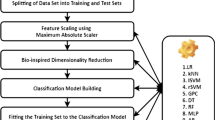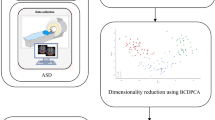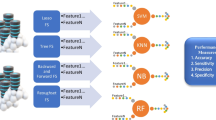Abstract
Parkinson’s is a brain disease that affects the quality of human life significantly with very slow progresses. It is known that early diagnosis is of great importance to arrange relevant and efficient treatments. Data analytics and particularly predictive approaches such as machine learning techniques can be efficiently used for earlier diagonosis. As a typical big data problem, the number of features in the collected data of Parkinson’s symptoms per case matters crucially. It is known that the higher the number of features considered the more complexities incur in the handling algorithms. This leads to the dimensionality problem of datasets, which requires optimisation to overcome the trade-off between complexity and accuracy. In this study, artificial bee colony-based feature selection methods are employed in order to select the most prominent features for successful Parkinson’s Disease classification over the datasets. The optimised set of features were used in training and testing k nearest neigbourhood algorithm, and then verifed with support vector machine algorithm over the public dataset. This study demonstrates that binary versions of artificial bee colony algorithms can be significanlty successful in feature selection in comparison to the relevant literature.
Access this chapter
Tax calculation will be finalised at checkout
Purchases are for personal use only
Similar content being viewed by others
References
Wang, H., et al.: Global, regional, and national life expectancy, all-cause mortality, and cause-specific mortality for 249 causes of death, 1980–2015: a systematic analysis for the Global Burden of Disease Study 2015. Lancet 388(10053), 1459–1544 (2016)
Oertel, W.H.: Recent advances in treating Parkinson’s disease. F1000Research, 6 Mar 2017
Massano, J., Bhatia, K.P.: Clinical approach to Parkinson’s disease: features, diagnosis, and principles of management. Cold Spring Harb. Perspect. Med. 2(6), a008870 (2012)
Little, M.A., McSharry, P.E., Roberts, S.J., Costello, D.A., Moroz, I.M.: Exploiting nonlinear recurrence and fractal scaling properties for voice disorder detection. BioMed. Eng. OnLine 6(1), 1–19 (2007)
Little, M.A., McSharry, P.E., Hunter, E.J., Spielman, J., Ramig, L.O.: Suitability of dysphonia measurements for telemonitoring of Parkinson’s disease. IEEE Trans. Biomed. Eng. 56(4), 1015–1022 (2009)
Cai, Z., et al.: An intelligent Parkinson’s disease diagnostic system based on a chaotic bacterial foraging optimization enhanced fuzzy KNN approach. Comput. Math. Methods Med. 1–24, 2018 (2018)
Das, R.: A comparison of multiple classification methods for diagnosis of Parkinson’s disease. Expert Syst. Appl. 37(2), 1568–1572 (2010)
Düğnci, M., Aydin, M.E.: A honeybees-inspired heuristic algorithm for numerical optimisation. Neural Comput. Appl. 1-15 (2019)
Li, D.C., Liu, C.W., Hu, S.C.: A fuzzy-based data transformation for feature extraction to increase classification performance with small medical data sets. Artif. Intell. Med. 52(1), 45–52 (2011)
Chen, H.L., Wang, G., Ma, C., Cai, Z.N., Liu, W.B., Wang, S.J.: An efficient hybrid kernel extreme learning machine approach for early diagnosis of Parkinson’s disease. Neurocomputing 184, 131–144 (2016)
Zuo, W.L., Wang, Z.Y., Liu, T., Chen, H.L.: Effective detection of Parkinson’s disease using an adaptive fuzzy k-nearest neighbor approach. Biomed. Signal Process. Control 8(4), 364–373 (2013)
Gük, M.: An ensemble of k-nearest neighbours algorithm for detection of Parkinson’s disease. Int. J. Syst. Sci. 46(6), 1108–1112 (2015)
Sakar, B.E., et al.: Collection and analysis of a Parkinson speech dataset with multiple types of sound recordings. IEEE J. Biomed. Health Inf. 17(4), 828–834 (2013)
Zhang, H.-H., et al.: Classification of Parkinson’s disease utilizing multi-edit nearest-neighbor and ensemble learning algorithms with speech samples. BioMed. Eng. OnLine 15(1), 122 (2016)
Abrol, V., Sharma, P., Sao, A.K.: Greedy dictionary learning for kernel sparse representation based classifier. Pattern Recogn. Lett. 78, 64–69 (2016)
Refaeilzadeh, P., Tang, L., Liu, H.: Cross-validation. In: Encyclopedia of Database Systems, pp. 532–538, Springer, Berlin (2009)
Sakar, C.O., et al.: A comparative analysis of speech signal processing algorithms for Parkinson’s disease classification and the use of the tunable Q-factor wavelet transform. Appl. Soft Comput. 74, 255–263 (2019)
Cai, J., Luo, J., Wang, S., Yang, S.: Feature selection in machine learning: a new perspective. Neurocomputing 300, 70–79 (2018)
Yusta, S.C.: Different metaheuristic strategies to solve the feature selection problem. Pattern Recogn. Lett. 30(5), 525–534 (2009)
Nguyen, B.H., Xue, B., Zhang, M.: A survey on swarm intelligence approaches to feature selection in data mining. Swarm Evol. Comput. 54, 100663 (2020)
Karaboga, D., Basturk, B.: A powerful and efficient algorithm for numerical function optimization: artificial bee colony (ABC) algorithm. J. Glob. Optim. 39(3), 459–471 (2007)
Karaboga, D., Gorkemli, B., Ozturk, C., Karaboga, N.: A comprehensive survey: artificial bee colony (ABC) algorithm and applications. Artif. Intell. Rev. 42(1), 21–57 (2014)
Kiran, M.S., Gunduz, M.: XOR-based artificial bee colony algorithm for binary optimization. Turk. J. Electr. Eng. Comput. Sci. 21, 2307–2328 (2013)
Kashan, M.H., Nahavandi, N., Kashan, A.H.: DisABC: A new artificial bee colony algorithm for binary optimization. Appl. Soft Comput. 12(1), 342–352 (2012)
Durgut, R.: Improved binary artificial bee colony algorithm. arXiv preprint arXiv:2003.11641
Santana, C.J., Macedo, M., Siqueira, H., Gokhale, A., Bastos-Filho, C.J.A.: A novel binary artificial bee colony algorithm. Future Gener. Comput. Syst. 98, 180–196 (2019)
Altay, E. V., Alatas, B. : Multi-objective association analysis of Parkinson disease with intelligent optimization algorithms. In: Proceedings of the 1st International Informatics and Software Engineering Conference (UBMYK), pp. 1–6, Ankara, Turkey (2019)
Badem, H., Turkusagi, D., Caliskan, A., Çil, Z.A.: Feature selection based on artificial bee colony for Parkinson disease diagnosis. In: Medical Technologies Congress (TIPTEKNO), İzmir. Turkey 2019, 1–4 (2019)
Tuncer, T., Dogan, S.: A novel octopus based Parkinson’s disease and gender recognition method using vowels. Appl. Acoust. 155, 75–83 (2019)
Castro, C., Vargas-Viveros, E., Sanchez, A., Gutierrez-Lopez, E., Flores, D.L.: Parkinson’s disease classification using artificial neural networks. In: VIII Latin American Conference on Biomedical Engineering and XLII National Conference on Biomedical Engineering, Cancun, Mexico, pp. 1060–1065 (2020)
Tuncer, T., Dogan, S., Acharya, U.R.: Automated detection of Parkinson’s disease using minimum average maximum tree and singular value decomposition method with vowels. Biocybern. Biomed. Eng. 40(1), 211–220 (2020)
Author information
Authors and Affiliations
Corresponding author
Editor information
Editors and Affiliations
Rights and permissions
Copyright information
© 2020 The Editor(s) (if applicable) and The Author(s), under exclusive license to Springer Nature Switzerland AG
About this paper
Cite this paper
Durgut, R., Baydilli, Y.Y., Aydin, M.E. (2020). Feature Selection with Artificial Bee Colony Algorithms for Classifying Parkinson’s Diseases. In: Iliadis, L., Angelov, P., Jayne, C., Pimenidis, E. (eds) Proceedings of the 21st EANN (Engineering Applications of Neural Networks) 2020 Conference. EANN 2020. Proceedings of the International Neural Networks Society, vol 2. Springer, Cham. https://doi.org/10.1007/978-3-030-48791-1_26
Download citation
DOI: https://doi.org/10.1007/978-3-030-48791-1_26
Published:
Publisher Name: Springer, Cham
Print ISBN: 978-3-030-48790-4
Online ISBN: 978-3-030-48791-1
eBook Packages: Computer ScienceComputer Science (R0)




